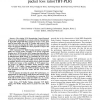Free Online Productivity Tools
i2Speak
i2Symbol
i2OCR
iTex2Img
iWeb2Print
iWeb2Shot
i2Type
iPdf2Split
iPdf2Merge
i2Bopomofo
i2Arabic
i2Style
i2Image
i2PDF
iLatex2Rtf
Sci2ools
IC
2004
2004
An Efficient TCP Buffer Tuning Technique Based on Packet Loss Ratio (TBT-PLR)
The existing TCP (Transmission Control Protocol) is known to be unsuitable for a network with the characteristics of high BDP (Bandwidth-Delay Product) because of the fixed small or large buffer size at the TCP sender and receiver. Thus, some trial cases of adjusting the buffer sizes automatically with respect to network condition have been proposed to improve the end-to-end TCP throughput. ATBT (Automatic TCP Buffer Tuning) attempts to assure the buffer size of TCP sender according to its current Congestion Window size (CWND), but the ATBT assumes that the buffer size of TCP receiver is maximum value that operating system defines. In DRS(Dynamic Right Sizing), by estimating the TCP arrival data of two times the amount TCP data received previously, the TCP receiver simply reserves the buffer size for the next arrival, accordingly. However, we do not need to reserve exactly two times of buffer size because of the possibility of TCP segment loss. We propose an efficient TCP buffer Tuning...
Buffer Size | IC 2004 | IC 2007 | Tcp Buffer | TCP Sender |
| Added | 31 Oct 2010 |
| Updated | 31 Oct 2010 |
| Type | Conference |
| Year | 2004 |
| Where | IC |
| Authors | Gi-chul Yoo, Eun-sook Sim, Dongkyun Kim, Taeyoung Byun, Kookhan Kim, Okhwan Byun |
Comments (0)

